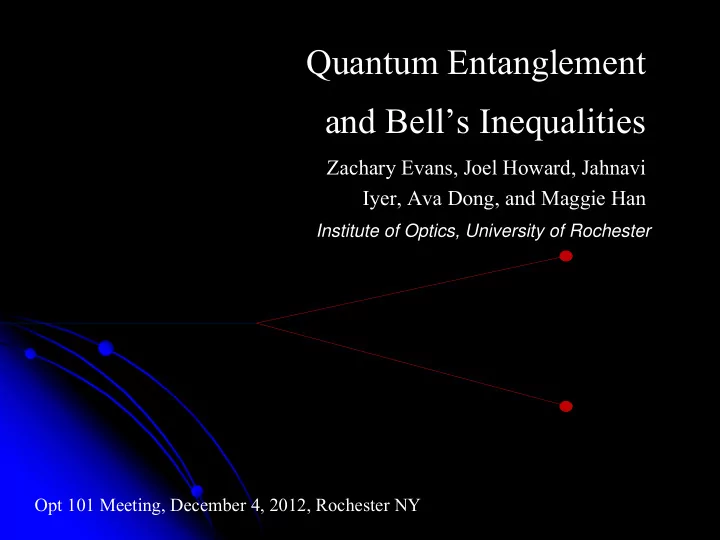

Quantum Entanglement and Bell’s Inequalities Zachary Evans, Joel Howard, Jahnavi Iyer, Ava Dong, and Maggie Han Institute of Optics, University of Rochester Opt 101 Meeting, December 4, 2012, Rochester NY
Entanglement, What is it? A state of being of two or more particles with special strong correlations Allows for reliable conclusions to be made about the state of one by the measurement of the state of the other Non local Multiple forms of entanglement (Energy, momentum, polarization, spin, etc…) Distance
Entanglement, What is it? A state of being of two or more particles with special strong correlations Allows for reliable conclusions to be made about the state of one by the measurement of the state of the other Non local Multiple forms of entanglement (Energy, momentum, polarization, spin, etc…) Distance
EPR and Bell EPR introduced entanglement, in 1935, but did not believe in it (“spooky action at a distance”) Einstein disagreed with non-locality, and sought an alternate explanation involving hidden variables to complete quantum mechanical theory. In 1964, John Bell developed a series of inequalities which allowed experimentalists to verify entanglement. Clauser, Horne, Shimony, and Holt created the commonly-used version of Bell’s Inequality. This experiment was made by Freedman and Clauser in 1972, and a more modern version was performed by Aspect in 1981 and 1982.
Experiment: Set Up 1. Laser 2. Quartz plate 3. BBO Crystals 4. Polarizers 5. Interference Filters 6. Avalanche Photodiode Modules (APD)
Experiment: Set Up BE VERY CAREFUL BE VERY CAREFUL BE VERY CAREFUL BE VERY CAREFUL BE VERY CAREFUL BE VERY CAREFUL Argon Ion Laser Photo Detectors, Collecting BBO Crystals ~363.8 nm System, Polarizers and ~727.62 nm Interference Filters
Experiment: BBO Crystals • Creates Two Cones of Entangled Photons Via SPDC 10 -10 Probability of photons SPDC • • Two Vertically Polarized, Two Horizontally Polarized from 45 degree incident polarization
Experiment: Quartz Plate • Compensates for the phase difference between the different polarizations that emerge from the BBO Crystal • Important to have overlapping cones
Collecting the Correct Photons Polarizer • Selects polarization Interference Filter • Rejects Laser light Microscope Objective • Focuses light into the optical fiber
Counting the Photons Avalanche Photo Detectors • Each detector detects single photons • Creates TTL pulses for the computer to read Computer chip counts the number of electrical pulses from each detector (singles) and simultaneous pulses (coincidences)
Basic Procedure 1. Create SPDC photons in BBO crystals 2. Change relative polarizer angle between polarizer A and B (angle A – angle B) 3. Measure number of simultaneous counts (coincidence count) for that relative angle, and repeat
How to Prove Evidence of Entanglement Bells Inequality's: • A series of classical relationships determines whether or not we have achieved entanglement. • If Bells inequality is violated for some value of parameters then entanglement is shown to occur • 16 Coincidence Count measurements to enter into the inequality and prove entanglement occurred
How to Prove it Bells Inequality's!! 16 Measurements at definite angles alpha and beta If S is greater than 2, entanglement has be shown to occur
Results: Bell’s Inequality Violation Angles N Values E Values S Value Polarizer Polarizer 2.240921 E(a,b) 0.830687 Coincidence counts A B 26.06104 -45 -22.5 E(a‘,b‘) 0.437502 4.683286 -45 22.5 3.020993 -45 67.5 21.81208 -45 112.5 E(a‘,b) 0.342053 16.1685 0 -22.5 23.45386 0 22.5 19.45366 E(a,b‘) -0.63068 0 67.5 6.812767 0 112.5 2.822459 45 -22.5 37.80719 45 22.5 37.1211 45 67.5 8.819509 45 112.5 6.171918 90 -22.5 12.08339 90 22.5 36.10151 90 67.5 24.83661 90 112.5 1 second acquisition time
Fringe Visibility Dependence of Coincidence Count of Relative Polarizer Angles 35 30 25 Polarizer A= 135 Coincidence Count 20 Degrees 15 Polarizer A= 45 Degrees 10 5 0 0 20 40 60 80 100 120 140 160 180 200 220 240 260 280 300 320 340 360 -5 Relative Polarizer Angle (Degrees) Fringe Visibility: 1 > 0.71
Singles Count Singles Count Vs. Angle for 90 Degrees 4000 Singles Count 3500 3000 2500 Singles Count A 2000 Singles Count B 1500 1000 500 0 0 50 100 150 200 250 300 350 Relative Polarization Degree Singles Count vs. Angle for 0 Degrees 5000 4500 4000 Singles Count 3500 3000 Singles Count A 2500 Singles Count B 2000 1500 1000 500 0 0 50 100 150 200 250 300 350 Relative Polarization Degree
Applications Of Entanglement -Quantum Computing -Quantum Encryption
Quantum Computing • Advantages of Quantum Computing • Speed up computation, and more powerful computation because the quantum computer might be able to do multiple calculations simultaneously. And it also means parallel calculation because of entanglement
Ekert Protocol Alice and Bob each receive one of a pair of entangled photons Measurements along parallel axes- key generation Oblique angles- test inequalities Evesdropping will destroy the entanglement and reduce the degree of violation in Bell's Inequalities.
Thank you Questions?
Referenced Sources http://science.howstuffworks.com/science-vs- myth/everyday-myths/quantum-cryptology6.htm http://news.bbc.co.uk/2/hi/science/nature/766131 1.stm http://arxiv.org/pdf/quant-ph/9912117.pdf http://plus.maths.org/content/os/issue35/features /ekert/index
Recommend
More recommend